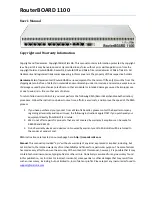
6
To disassemble the case, you will need a Phillips P2 screwdriver.
Powering
Power options:
1.
PoE on Ether13
supports 12-24V DC powering with a passive PoE injector. The device does not support
power over datalines.
2.
J11
power connector, used when device installed in a rackmount case, 12-24V DC. Connects to the
built-in PSU.
Booting options
First, RouterBOOT loader is started. It displays some useful information on the onboard RS232C asynchronous
serial port, which is set to 115200bit/s, 8 data bits, 1 stop bit, no parity by default. Also supports hardware
(RTS/CTS) flow control. The loader may be configured to boot the system from the onboard NAND module or
from Ethernet network. See the respective section of this manual for how to configure booting sequence and
other boot loader parameters.
Onboard NAND Storage Device
The RouterBOARD may be started from the onboard NAND storage chip. As there is no partition table on the
device, the boot loader assumes the first 4MiB form a YAFFS filesystem, and executes the file called “kernel”
stored in the root directory on that partition. It is possible to partition the rest of the medium by patching the
kernel source.
Internal Storage Device
The RouterBOARD may be started from a microSD card slot, although RouterOS doesn't support this. At least
two partitions must exist on the device, first of which being the ELF image the board is to be booted from
(normally, it is a Linux kernel, appended with the kernparm ELF section that specifies the root partition name
and, optionally, other kernel parameters of your choice).
Booting from network
Network boot works similarly to PXE or EtherBoot protocol, and allows you to boot a RouterBOARD 1100
series boards from an executable image stored on a TFTP server. It uses BOOTP or DHCP (configurable in boot
loader) protocol to get a valid IP address, and TFTP protocol to download an executable (ELF) kernel image
combined with the initial RAM disk (inserted as an ELF section) to boot from (the TFTP server's IP address and
the image name must be sent by the BOOTP/DHCP server).
To boot the RouterBOARD computer from Ethernet network you need the following:
An ELF kernel image for the loader to boot from (you can embed the kernel parameters and initrd image
as ELF sections called
kernparm
and
initrd
respectively)
A TFTP server which to download the image from
A BOOTP/DHCP server (may be installed on the same machine as the TFTP server) to give an IP address,
TFTP server address and boot image name
See the RouterBOOT section on how to configure loader to boot from network.
Note that you must connect the RouterBOARD you want to boot, and the BOOTP/DHCP and TFTP servers to
the same broadcast domain (i.e., there must not be any routers between them).





























